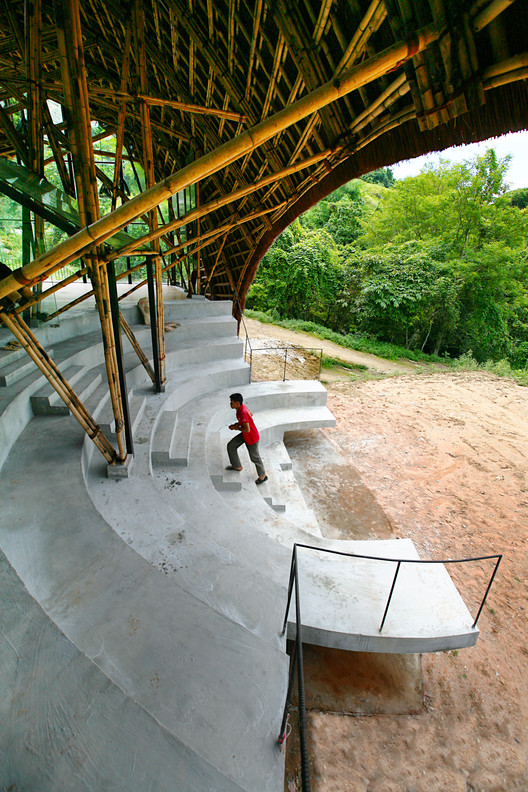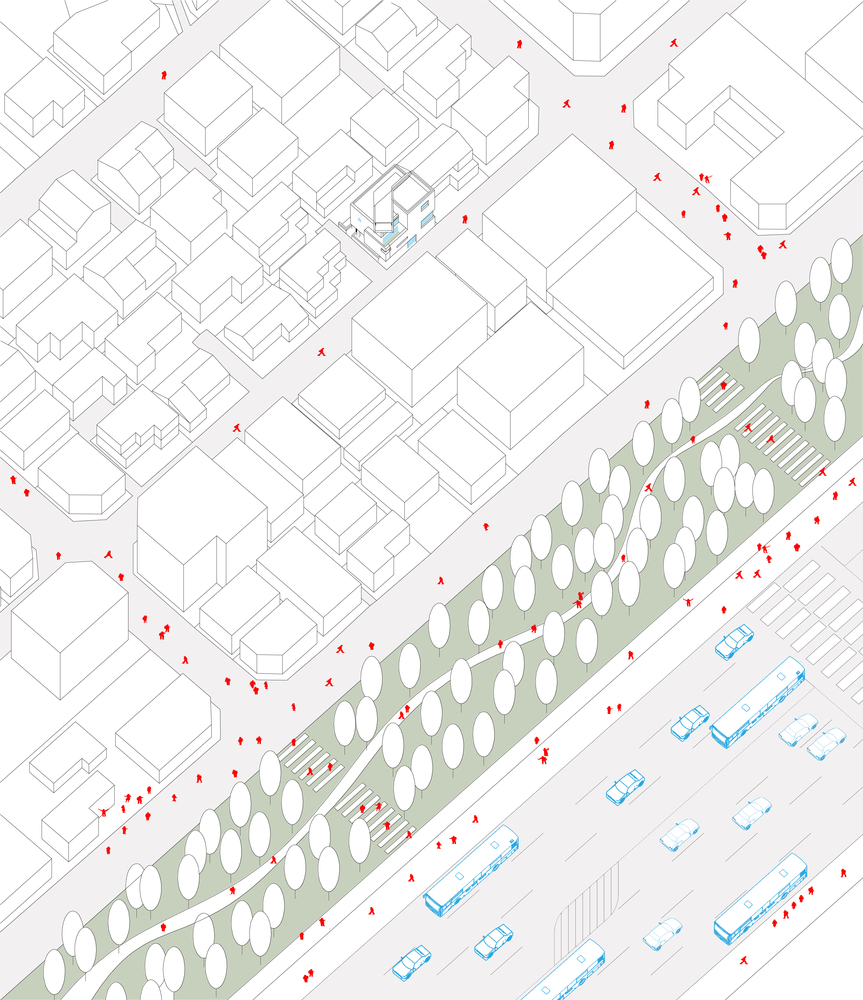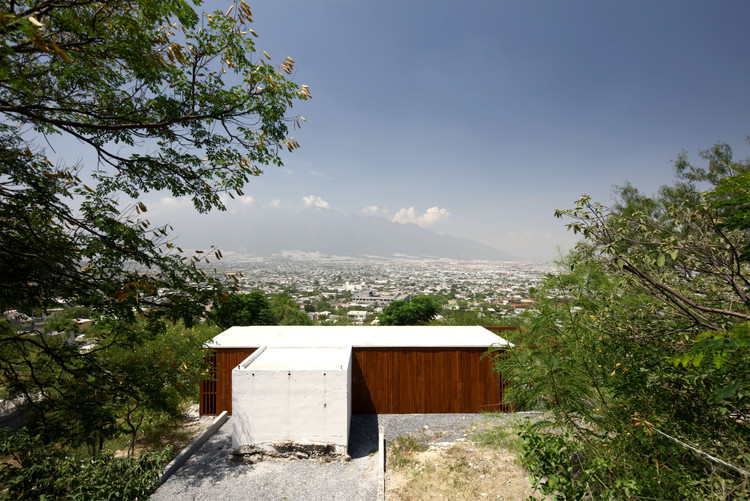The Dinosaur Egg Geological Museum Wuhan HUST architecture and urban planning design institute
2016-11-14 19:00
架构师提供的文本描述。云县地处中部山区,北纬32°40‘,东经110°37’,地处“夏热冬冷气候带”。博物馆的设计采用了当地所有的材料,当地的团队和当地的建筑技术。它努力用大多数本地的设计投入来创造最少的干扰。
Text description provided by the architects. Yunxian situates in the mountain area in central China, at 32°40′N, 110°37′E. It is in the “Hot-summer and Cold-winter climate zone”. The museum design adopts all local material, local teams and local construction techniques. It strives to create least disruption with most locally-sourced design input.
尽可能多地使用现浇混凝土、钢筋混凝土体系、当地施工队伍和当地材料.
Cast-in-place concrete, reinforced concrete system, local construction team and local materials are used as much as possible.
该设计采用当地快速生长的竹子作为混凝土模具,还采用废弃土屋的旧瓷砖作为屋顶的第二层。对于炎热的夏季气候区,它还有助于保持室内温度良好。没有任何装饰内外立面,只使用一些烟囱形状的光,以便在自然日光下吸引作为聚光灯的恐龙蛋。
The design used locally fast-grown bamboo as concrete molds, it also used old tiles from deserted local earth houses as the 2nd layer of roof. It also helps keep interior temperature in good condition for hot summer climate region. Without any decoration for inside and outside facade, only using some chimney-shaped light well in order to draw in natural daylight as spotlights for the dinosaur eggs.
根据被动式设计原则,博物馆无须使用任何空调及其他人工通风设施。
Following the passive design principle, the Museum does not need to use any air condition and other artificial ventilation facilities.
除了设计理念,当地材料和施工团队/技术的另一个好处是经济预算。场地条件,包括其地形和可达性,都是相当复杂的,这也导致了建筑形式的复杂性。使用当地的材料和当地的建筑技术也有助于确保一个适度的建筑预算,同时保持高质量的上下文设计。设计团队还经常前往施工现场,在友好的预算范围内交付质量控制的项目。
Aside from design philosophy, another benefit of the local material and construction team/technique is the economic budget. The site condition including its topography and accessibility is rather complicated, which also results in a building form complicated to construct. Using local material and local construction technique also helps to ensure a modest construction budget while keeping a high-quality contextual design. The Design team also made very frequent trips to the construction site to deliver quality-controlled project within a friendly budget.
设计的形态根源于恐龙蛋的空间分布和现场地形的垂直变化。该网站保持了最小的干扰,最低设计的步行桥轻轻漂浮在上面,拥抱周围的鸡蛋,这进一步决定了建筑的方向和形式,作为一个安静的背景为网站。这是一座对遗址谦逊,对历史诚实,对考古发掘尊重的建筑。
The morphology of the design roots in spatial distribution of the dinosaur eggs and vertical variation of the on-site topography. The site remained least disturbed, with the minimally- designed walking bridge gently floating above to hug around the site of the eggs, which further determines the direction and form of the architecture that serves as a silent backdrop for the site. It is a building that is modest to the site, honest to the history and respectful to the archaeological excavation.
Old material + New construction technique:
-快速生长的本地竹子被选为低成本的可持续材料。然而,传统材料的使用是与创新:竹子主要是用来制造模具,为混凝土提供独特的,粗糙和文本整理。-附近废弃的土屋的旧瓷砖也是以一种创新的方式回收的:它们被用来建造屋顶的第二层。两层屋顶使空气在两者之间流通,从而减少夏季进入建筑物的热量。-“光之烟囱”是用来为整个博物馆唯一展出的恐龙蛋提供简单而纯净的“自然聚光灯”。“光之烟囱”也为展览营造了一种神秘的气氛。
- The fast-growing local bamboo was chosen as a low-budget sustainable material. However the conventional material is used with innovation: the bamboo was used mostly to make molds that provides concrete a unique, rough and textual finishing. - The old tiles from deserted earth houses nearby were also recycled in an innovative way: They are used to constructed second layer of the roof. Two layers of roof enables the circulation of air in between, therefore minimizing heat from entering the building during the summer. - “The Chimneys of Light” are used to provide simple and pure “natural spotlight” for the dinosaur eggs, the only item on exhibition in the entire museum. “The Chimneys of Light” also construct a mysterious atmosphere for the exhibition.
创新的“透风遮光”窗口系统,解决了暗色室内环境与自然通风性展览感官环境的矛盾。
Innovative “wind-transparent but light-blocking” window system, solving conflicts between dark visual indoor environment and well-natural-ventilated exhibition sensual environment.
该项目从附近的河流和小溪中收集和堆放巨大的岩石,以保护建筑的基础。原状的天然草场和800年的古树是主要的景观特征,体现了建筑中自然和极简的设计原则。
The project collects and piles big rocks from rivers and creeks nearby to protect the foundation of architecture. The unaltered natural grass-field and 800-year-old ancient trees are the main landscape feature, which echoes the natural and minimalistic design principles from the architecture.
Architects Wuhan HUST architecture and urban planning design institute
Location Qinglong Mountain National Geological Park, China
Architect in Charge Baofeng Li, Jianmin Ding, Changshun Xu
 举报
举报
别默默的看了,快登录帮我评论一下吧!:)
注册
登录
更多评论
相关文章
-

描边风设计中,最容易犯的8种问题分析
2018年走过了四分之一,LOGO设计趋势也清晰了LOGO设计
-

描边风设计中,最容易犯的8种问题分析
2018年走过了四分之一,LOGO设计趋势也清晰了LOGO设计
-

描边风设计中,最容易犯的8种问题分析
2018年走过了四分之一,LOGO设计趋势也清晰了LOGO设计



































































